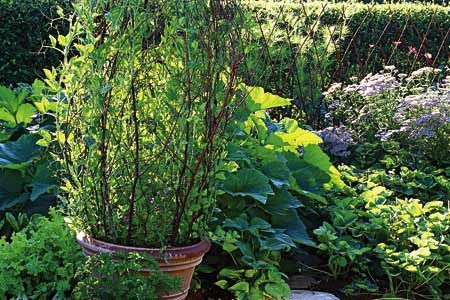We may be compensated if you purchase through links on our website. Our team is committed to delivering honest, objective, and independent reviews on home products and services.
Project details
Skill
Cost
Estimated Time
Building a branch trellis in a pot is an excellent way to add vertical interest to your garden while supporting climbing plants. This do-it-yourself project is cost-effective and allows you to create a unique, natural structure that complements your outdoor space. Using branches from your yard or local area, you can craft a beautiful, functional, and aesthetically pleasing trellis. This article will guide you through the process of creating your branch trellis, from selecting materials to enjoying the final product.
Step-By-Step Instructions to Build a Branch Trellis in a Pot
To build a branch trellis in a pot, Connecticut gardener Thyrza Whittemore uses dark-gray beech branches in big containers to support colorful sweet peas. While any hardwood cuttings can be used, a beech’s flat branching structure creates a conveniently tidy form. Sweet peas can reach 6 to 8 feet in height, so size branches accordingly.
Step 1: Put In the Largest Supports
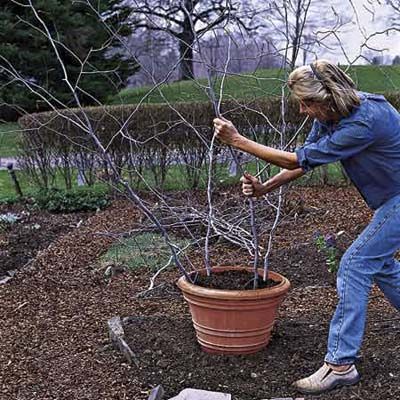
The first step in creating your branch trellis is establishing the main structure using the largest supports. Begin by selecting a container filled with rich potting soil, which will serve as the base for your trellis. Choose four tall branches, approximately 6 to 8 feet in height, to accommodate climbing plants like sweet peas that can reach these heights. Insert these branches firmly around the edges of the container and confirm they are evenly spaced and securely anchored in the soil. This creates a sturdy scaffold that will support the entire structure.
While beech branches are particularly graceful and well-suited for this project, you can use branches from various woody plants with ample side branching. Some excellent alternatives include butterfly bushes, Japanese maples, and birch. You may also consider high-bush blueberries, dogwood, or willow.
When selecting branches, look for those with a natural, appealing shape and sturdy structure. This will contribute to the look of your trellis while providing reliable support for your climbing plants. Opting for wind-resistant branches will help the trellis remain standing even in adverse weather conditions.
Step 2: Add Smaller Branches
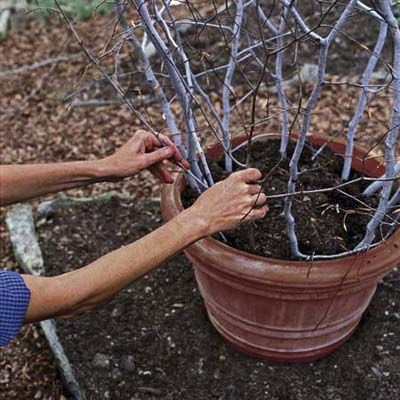
Once the main supports are in place, it’s time to add smaller branches to create a more intricate structure for your climbing plants. Insert these smaller branches into the soil between each of the large supports. This step is important for providing additional anchor points and creating a more robust framework for your plants to climb.
When adding smaller branches, consider the following tips to achieve a harmonious design:
- Vary the heights of the branches to create visual interest and provide plenty of fine twigs for plant tendrils to grasp.
- Weave shorter branches horizontally between the vertical supports to form a lattice pattern.
- Trim any branches that stick out too far or disrupt the overall shape, maintaining a streamlined, tidy appearance.
Step back occasionally to assess the overall structure and adjust as needed as you work. The goal is to create a balanced, natural-looking trellis that effectively supports your chosen climbing plants.
Step 3: Tie the Top

After arranging the smaller branches, the next step is to secure the structure by tying the tops of the tallest branches together. This adds stability to your trellis and creates an attractive, cohesive shape that crowns the entire piece. Gather the tallest branches near their tops and use a sturdy twine or garden wire to tie them together securely, forming a natural focal point.
When tying the top of your trellis, remember these points to maximize durability and give it an appealing look:
- Use a weather-resistant material for tying, such as jute twine or coated wire.
- Make sure the knot is tight enough to hold the branches in place but not so tight that it damages the wood.
If the trellis leans to one side, gently adjust the position of the branches in the soil to maintain its uprightness. Remember that you may need to repeat the tying process or adjust as the branches settle and the plants grow.
Step 4: Fill In
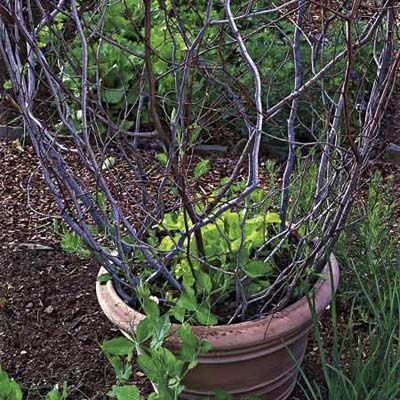
With the main structure in place, it’s time to fill gaps and create a denser network for your climbing plants. This step involves adding another round of smaller branches to create a more intricate structure. As you fill in the trellis, focus on creating a balanced, natural-looking design that provides ample plant support.
Consider these techniques when filling in your trellis to enhance growth opportunities for your vining companions:
- Insert additional small branches to fill noticeable holes or gaps, crafting a uniform framework.
- Tuck in, tie, or trim stray twigs inside the structure as needed, reducing visual clutter and maintaining neat lines.
- Create horizontal crosspieces by weaving flexible branches between the vertical supports to improve the climbing grid.
Confirm there are enough attachment points at various heights for climbing plants, creating a multi-level tapestry of greenery. Once you’re satisfied with the structure, it’s time to plant your chosen climbing plants. Sweet peas are an excellent choice for this type of trellis, but you can also consider other vining plants such as morning glories, clematis, and jasmine.
For added interest and productivity, consider planting quick-growing vegetables or herbs in the center of the container. Lettuce is an excellent choice as it fills the space quickly, and you can harvest it before the climbing plants take over. Incorporating edible greens adds a delightful, practical touch to your trellis creation.
Step 5: Enjoy the Show
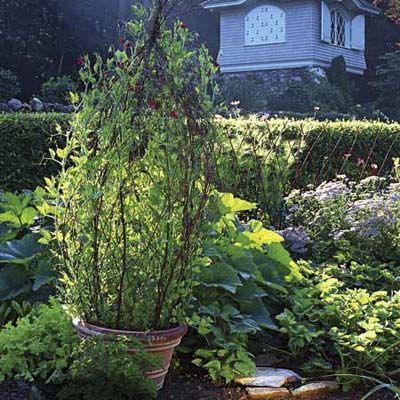
As your plants grow and climb the trellis, you’ll enjoy a beautiful, ever-changing display throughout the growing season. Placing your climbing plant container in a vegetable bed or among other garden features adds vertical interest and long-lasting color to your outdoor space. Watching your trellis fill with life can be one of the most rewarding aspects of this project.
Follow these maintenance tips to keep your branch trellis and plants looking their best:
- Water frequently, especially during hot or dry periods, and consider mixing moisture-retaining granules into the soil to help prevent the pot from drying out.
- Regularly tuck in any stray shoots to maintain a tidy appearance that effectively showcases your handiwork.
- Deadhead spent blooms to encourage continued flowering and a vibrant array of foliage.
Fertilize your plants according to their needs to promote healthy growth and flourishing vines. As the season progresses, you may need to make minor adjustments to the trellis structure or plant growth. This ongoing care will help your branch trellis remain a stunning focal point in your garden throughout the growing season.
Our Conclusion
Creating a branch trellis in a pot is a rewarding do-it-yourself project combining natural materials and creative design. This unique structure supports climbing plants and adds a rustic, organic element to your garden. Following these steps and maintaining your trellis throughout the season, you’ll enjoy a beautiful, ever-changing display that enhances your outdoor space.
